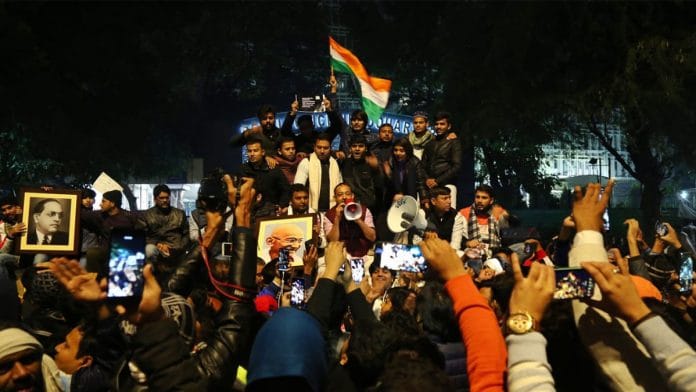India has exploded into protests against a citizenship law that explicitly discriminates against its 200 million-strong Muslim population. Narendra Modi’s Hindu nationalist government has responded with police firing on demonstrators and assaults on university campuses.
The global wildfire of street protests, from Sudan to Chile, Lebanon to Hong Kong, has finally reached the country whose 1.3 billion population is mostly below the age of 25. The social, political, and economic implications couldn’t be more serious.
It was only last month that students on the campus of Hong Kong Polytechnic University were throwing petrol bombs at the police, and fielding, in turn, teargas, rubber bullets and water cannons.
This violent resistance to an authoritarian state is novel to Hong Kong. The Umbrella Movement that in 2014 first expressed a mass sentiment for greater autonomy from Beijing was strikingly peaceful. The campaigners for democracy in Hong Kong today have also traveled very far away from the Chinese students who occupied Tiananmen Square in 1989, and to whom they have been wrongly compared.
Those students back in 1989 were deeply respectful of their state: Photographs of student petitioners kneeling on the steps of the Great Hall of the People are no less eloquent than the iconic picture of a protester facing a tank.
That acknowledgement of the state’s authority as ultimate arbiter is now rapidly disappearing, in not only Hong Kong, but also India and many other countries. It is being replaced by the conviction that the state has lost its legitimacy through cruel and malign actions.
Today’s protesters, who are overwhelmingly young, are usefully compared to the French student demonstrators in Paris in 1968. The latter occupied places of work and study, streets and squares. They also met police crackdowns with makeshift barricades and Molotov cocktails.
Like today’s protesters, the French students erupted into violence amid a global escalation of street-fighting; they claimed to reject an older generation’s values and outlook. And they, too, couldn’t be simply classified as left-wing, right-wing or centrists.
Indeed, the French radicals confused many people at the time because they loathed the French communist party almost as much as they did the parties of the right. The French communists, in turn, dismissed the protesting students as “anarchist.”
This commonplace pejorative confuses anarchism with disorganization. It should be remembered that anarchist politics is one of the modern world’s oldest, if little remembered, political and intellectual traditions. Today, it best describes the radical new turn to protests worldwide.
Anarchist politics began to emerge from the mid-19th century onward, originally in societies where ruthless autocrats were in power — France, Russia, Italy, Spain, even China — and where hopes of change through the ballot box seemed wholly unrealistic.
The anarchists — one of whom assassinated U.S. President McKinley in 1901 — sought freedom from what they saw as increasingly exploitative modes of economic production. But, unlike socialist critics of industrial capitalism, they aimed most of their energies at liberation from what they saw as tyrannical forms of collective organization — namely, the state and its bureaucracy, which in their view could be communist as well as capitalist.
As Pierre-Joseph Proudhon, the pioneering thinker of anarchism (and robust critic of Marx), put it, “To be GOVERNED is to be kept in sight, inspected, spied upon, directed, law-driven, numbered, enrolled, indoctrinated, preached at, controlled, estimated, valued, censured, commanded, by creatures who have neither the right, nor the wisdom, nor the virtue to do so.”
For many anarchists, the state, the bureaucracy and security forces were the deepest affront to human dignity and liberty. They sought to achieve democratic freedoms by a drastic reduction in the power of the hydra-headed state, and a simultaneous intensification of the power of individuals from below through coordinated action.
Democracy for the anarchists was not a distant goal, to be reached through vertically integrated political parties, impersonal institutions and long electoral processes. It was an existential experience, instantly available to individuals by jointly defying oppressive authority and hierarchy.
They saw democracy as a permanent state of revolt against the over-centralized state and its representatives and enforcers, including bureaucrats and the police. Success in this endeavor was measured by the scale and intensity of the revolt, and the strength of solidarity achieved, rather than by any (always unlikely) concession from the despised authorities.
This is also how protesters today seem to perceive democracy as they struggle, without much hope of any conventional victory, against governments that are as ideologically driven as they are ruthless.
Let there be no doubt: More open and unresolvable conflicts between ordinary citizens and authorities are likely to become the global norm rather than the exception. Certainly, militant disaffection today is not only more extensive than it was in the late 1960s. It also connotes a deeper political breakdown.
Negotiations and compromise between different pressure groups and interests that have defined political society for ages suddenly seem quaint. Old-style political parties and movements are in disarray; societies, more polarized than ever before; and the young have never faced a more uncertain future. As angry, leaderless individuals revolt against increasingly authoritarian states and bureaucracies from Santiago to New Delhi, anarchist politics seems an idea whose time has come.-Bloomberg
Also read: Citizenship, Article 370, SC-ST Act: Muslims, Kashmiris, Dalits protest in silos in India







The exceptional cruelty with which the police dealt with students in Jamia Millia and AMU is something that will come back to haunt the authorities. We continue to disregard Justice Chandrachud’s advice that dissent is like a safety valve for democracy.
Yes, it reminded me of the Jallianwala massacre — without any prompt from Sonia Sena.